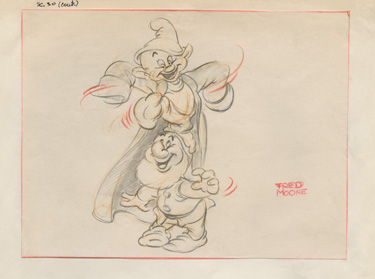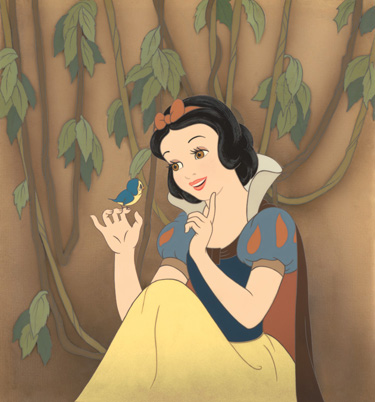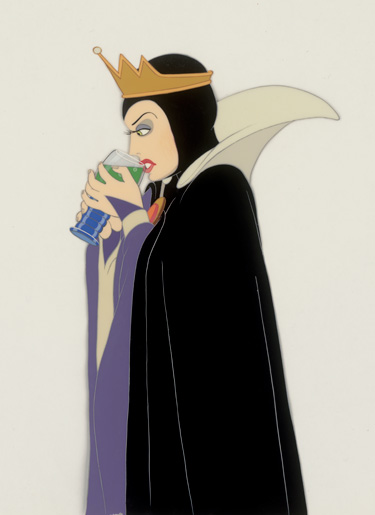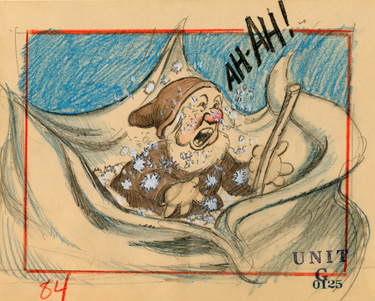 |
 |
Dopey and Sneezy Dancing
Fred Moore, American (1911–1952)
Story sketch: graphite, ink, and colored pencil on paper
Walt Disney Animation Research Library
|
Gags were a good way to shift the action, as shown in this scene
in which Sneezy's inevitable sneeze ends the dancing sequence
and transitions into Snow White's storytelling scene.
The creation of individualized dwarfs reflects one of the film's
most dramatic departures from the Grimms' fairy tale. As the
story artists developed the dwarfs' characters and realized the
important role they would play in Snow White, changes began to
be made to the story. Even though Walt Disney had completed a
fairly comprehensive adaptation of the story by 1935, much of
the early material was discarded as the film developed and Walt's
high standards for the final product led to refinements.
Dopey's oversized clothing and lack of facial hair mark him as
younger than the other dwarfs. He was so popular and received
so much fan mail that there was some speculation that the
Studio would make a series of shorts featuring him. However,
there is no direct evidence that Walt seriously considered making
them. Like Mickey Mouse, each of the dwarfs has three fingers
and a thumb on each hand. This was a deliberate choice to make
the process of animating them less time-consuming.
PROCESS
Animation is the act of generating motion through sequences of
individual images. For every second of animation in Snow White,
twelve to twenty-four drawings were required. Animators hand-
drew every movement and expression of each character,
changing each with successive sheets of animation paper.
The lead animator made "ruffs," rough pencil sketches of the
movement's extreme limits, concentrating on the dynamics of
motion and acting. Assistants, or "inbetweeners," produced
intermediary drawings, bridging the movement between the
key drawings. Cleanup artists reworked the rough sketches,
turning them into finished drawings. |
 |
 |
Snow White Greets a Baby Bird
Disney Studio Artist
Reproduction cel setup; airbrushed post production
background on paper
Courtesy Walt Disney Animation Research Library;
© Disney
|
Snow White's sweet encounter with the lost baby bird reinforces for the audience that she has a close connection to animals. Her
action helps inspire the Huntsman's sudden change of heart.
Several artists were assigned to an "animal unit" was established
to focus on creating Snow White's many forest friends.
Snow White appears as an innocent young girl in some story
sketches, and as a slightly more mature young woman in others.
Both aspects of her personality were retained in the finished film:
animator Ham Luske and his unit brought out her wide-eyed
innocence, while Grim Natwick and his assistants tended toward a
somewhat more mature version of the character.
Some early concept drawings depicted Snow White in a delicate,
illustrative manner, similar to characters in children's storybooks.
Avoiding the question of Snow White's exact age, Walt Disney
instructed his artists to make her appear "old enough to marry."
Disney artists had practiced animating the female form in earlier
films, such as The Goddess of Spring, a Silly Symphony cartoon
released in 1934. With Walt's vision and encouragement, they
developed sophisticated new artistic techniques and leapt light-
years ahead while working on Snow White, achieving convincing
animated human form and movement for the first time. |
 |
 |
Queen drinking her Magic Potion
Disney Studio Artist
Cel: ink and acrylic on cellulose acetate
David Pacheco Collection
© Disney
|
The bold, saturated, dark colors used to depict the Queen in her castle underscore her strength and provide a contrast with the
bright colors and softer surroundings used for images of Snow
White. At an early production meeting regarding the use of color
in the film, Walt Disney emphasized,
"We are trying to achieve something different here. We have to
strive for a certain depth and realism."
This painting reveals how the choice of color throughout the film
became integral to character development.
Concept artists experimented with various looks for the vain
Queen. Some early sketches were comical, but the final character
was tall and aristocratically beautiful. The resulting contrast
between her beauty and her wicked heart makes her that much
more menacing.
Walt Disney was intent on having each film from the Disney
Studio viewed as a unified whole, rather than as a composite of
parts made by many individuals. For this reason, artists were
asked not to sign their artwork. As a result, much of the artwork
in the exhibition is credited to "Disney Studio Artist." |
 |
 |
Sneezy in the Mattress
Disney Studio Artist
Story sketch
graphite and colored pencil on paper
Courtesy Walt Disney Animation Research Library;
© Disney
|
Walt Disney and his team decided that each dwarf should
represent a common human personality type and be named
accordingly. In developing the characters, even characteristics
like facial hair were carefully considered. Six of the final dwarfs
have eyebrows fashioned after Walt's own expressive eyebrows,
which fascinated everyone who ever sat in story meetings with
him. Happy is the only exception: his eyebrows are white and
bushy.
The names of Disney's Seven Dwarfs were new; the individual
dwarfs had not been named in traditional versions of the tale.
During the production, approximately fifty names were
considered but not selected, including:
Baldy Dizzy Hotsy Sappy Tearful
Blabby Doleful Hungry Scrappy Thrifty
Burpy Flabby Hoppy Shifty Tipsy
Busy Gabby Jaunty Silly Tubby
Cranky Gloomy Jumpy Soulful Weepy
Daffy Goopy Lazy Sniffy Wistful
Deafy Graceful Neurtsy Snoopy Woeful
Dippy Helpful Nifty Stuffy
|
| |
| |
|

